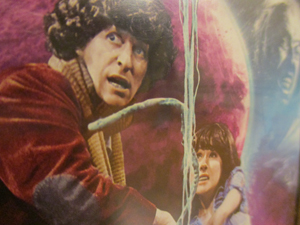Planet of Evil
“You call it ‘nothing’—a word to cover ignorance…” – The Doctor
This story marks the true start of Phillip Hinchcliffe as producer as it begins a long and successful run of Doctor Who stories adapted from or using imagery of classic sci-fi and horror films, in this case Forbidden Planet with a good dose of Dr. Jekyll and Mr. Hyde. The most striking thing about this story by far is the design. The alien jungle they create in studio is amazingly well realized from top to floor such that it really looks like they are tromping through tangles of vines and marsh. The darkened, color-tinted lighting brings a real mood to the whole set. They even make an innovative use of light for the ray guns used by the military—the blue lights that flash in the barrels of the guns are followed by a well-timed blue light flash across at a distant. In the darkness of the set, it really looks good—a much better effect than ray bolts drawn in post-production. The effects used to portray the largely invisible antimatter monsters echo the design of the Forbidden Planet Id creature. There are even some nice moments for the model spaceship and planet used.
As for the story itself, it’s a somewhat exciting sci-fi tale using the idea of a junction between matter and anti-matter universes. The science is a bit daft—antimatter as rocks (?), infections that turn the professor into an “anti-man”—but if you ignore all that it’s a fun romp because of the well-done sense of tension in the siege by the anti-matter copies or Sarah’s paralyzing dread. I’m not sure it was intended, but there is a bit of disorientation at the beginning when the Doctor and Sarah arrive and find the husk corpses of the people we’ve seen attacked. One assumes they are arriving right after the events we just witnessed but the desiccated corpses say otherwise and the Doctor does note the distress signal that brought them is on automatic. Just as we start to think months have passed, Sorenson turns up noting his discovery from the previous night. This throws the explanations of the remains into question—either a great bit of misdirection or sloppy story telling.
There are some missteps in characterization — Salamar is a bit overbearing, for example, but not presented as so fragile of an ego that he would spectacularly snap into madness at being challenged as he does. There is, however, a brilliant scene where the Doctor reaches Sorenson’s conscience. He convinces Sorenson to sacrifice himself in time to save others with the line “You and I are scientists, Professor. We buy our privilege to experiment at the cost of total responsibility.” It’s too bad that the gambit fails by seconds and Sorenson is fully transformed–but even more surprising when Sorenson survives in the end
Best (or worst) unsettling moment:
Sorenson’s glowing blank eyes are creepy and a pretty well done effect for the time period. The most trippy part of the story, however, is the Doctor’s long almost unending fall in the blankness of the anti-matter realm. The spinning camera in a void of black with the Doctor flailing around until being suspended in mid-air facing the antimatter beast is pretty amazing.
Firsts:
- Anti-matter
Regrets:
I don’t mind that the story’s science doesn’t square with reality but there is some internal inconsistency that is irritating. For example, the characters dismiss the idea of the other universe as preposterous at one point and then just a little bit later are talking about it as if they had known of it all along and that it was the known focus of expedition.

